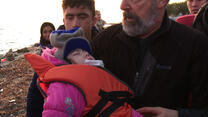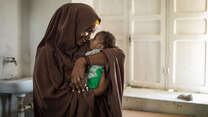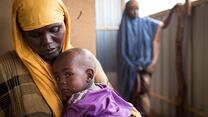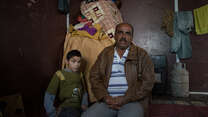A little girl in a brightly flowered sundress lies listlessly on an iron hospital bed. Her name is Falastine Mohamed Ahmed. She is eight years old.
Falastine’s eyes are half-closed and her head lolls from side to side. Her mother, Hasno, sits next to her in a plastic chair, caressing her daughter’s plaited hair. Her father, Mohamed, watches over her from the other end of the bed. Their faces show exhaustion and worry—they have been here at the International Rescue Committee medical clinic for four days.
A doctor and nurse arrive to attach a new intravenous drip to Falastine’s left arm to replace the fluids she’s lost to relentless diarrhea. The doctor asks the girl, “Can I give you some water?” She shakes her head no, too weak to drink from the cup put to her lips. “You will be okay,” the doctor reassures her.
Falastine, her two younger siblings, and their mother became sick soon after they arrived, two weeks ago, at a camp outside the city of Mogadishu—one of the hundreds of thousands of Somalis displaced from drought-stricken villages. They all started to improve after a visit to a local health center, but just after midnight Falastine took a turn for the worse and began vomiting.
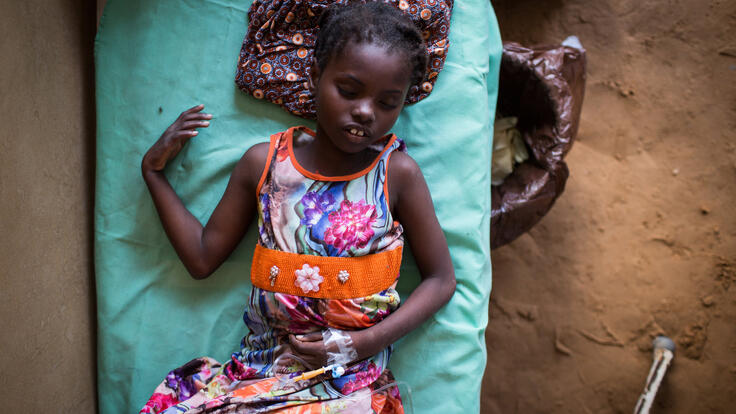
She was taken by ambulance to the IRC clinic in the camp, where she was put on the drip and given medication. But even after days of treatment, she barely notices the noise and bustle around her in the crowded children’s ward, or the words of encouragement she receives from the doctors and nurses who check on her regularly.
“All the children are sick, and there is nowhere I can work,” says her anxious father, a farmer who raised goats back home in Lower Shabelle before the drought decimated crops and livestock across the region. He is one of the nearly 3 million Somalis who urgently need food and help making ends meet as the crisis worsens. When he’s not at the clinic with Falastine, Mohamed has been looking for odd jobs, including strenuous stone-breaking, to support his family until they can return to their farm and start over.
Mohamed and his family survived the drought that devastated Somalia in 2011 by drawing water from a river that kept flowing despite scant rainfall. This one, he says, is far worse. “We have no rain and the river is dry … and disease on top of that. People don’t know where to go.”
In all, more than 1 million Somalis have been displaced inside their country by drought and terrorism. Many are living in makeshift shelters in crowded conditions that are ripe for the spread of disease. And the violence that has gripped Somalia for decades has seriously weakened the country’s health care system, making it difficult for people to get medical attention.
“These people really are in need of help,” says IRC deputy program director Abukar Mohamud Ga'al. “There is lack of food, there is lack of medical supplies and health assistance.”
Falastine needs more intensive care than the clinic can provide. Her doctor has referred her to the nearby Banadir Hospital, also supported by the IRC. Mohamed gently lifts his little girl from the bed and carries her down the hall, his wife just behind him. They pray that they will be able to get their daughter the treatment she needs to survive.
